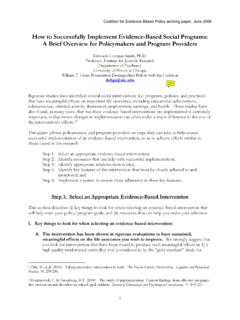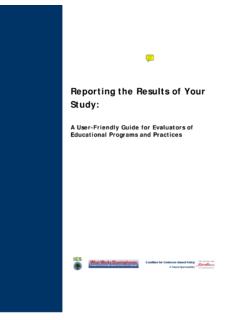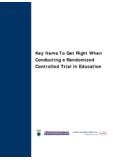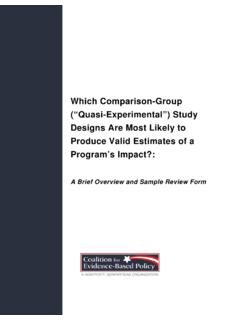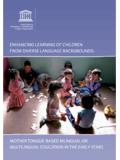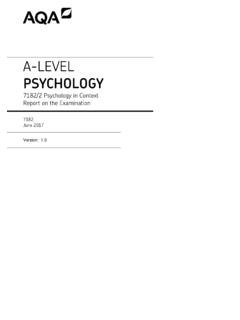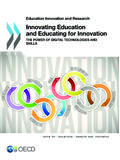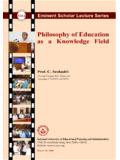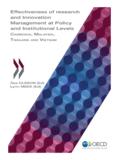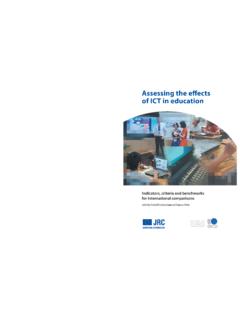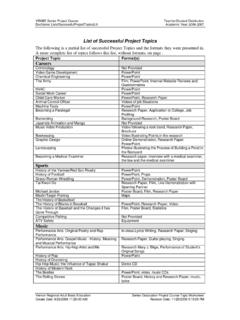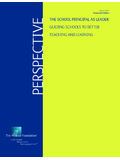Transcription of Hierarchy of Study Designs for Evaluating the ...
1 Hierarchy of Study Designs for Evaluating the effectiveness of a stem education Project or Practice 2 Published in 2007 This publication was produced by the Coalition for Evidence-Based Policy, with funding support from the William T. Grant Foundation, Edna McConnell Clark Foundation, and Jerry Lee Foundation. This publication is in the public domain. Authorization to reproduce it in whole or in part for educational purposes is granted. We welcome comments and suggestions on this document 3 Hierarchy of Study Designs For Evaluating the effectiveness of a stem education Project or Practice This document contains a narrative overview of the Hierarchy , followed by a one-page graphic summary. Purpose of the Hierarchy : To help agency/program officials assess which Study Designs are capable of producing scientifically-valid evidence on the effectiveness of a stem education project or practice ( intervention 1 ).
2 More specifically, the Hierarchy Encompasses Study Designs whose purpose is to estimate an intervention s effect on educational outcomes, such as student math/science achievement, or completion. (These are sometimes called impact studies.) The Hierarchy does not apply to other types of studies that serve other purposes ( , implementation studies, longitudinal cohort studies).2 Recognizes that many Designs , including less rigorous impact studies,3 can play a valuable role in an overall research agenda. It is not meant to imply that rigorous impact studies are appropriate for all interventions, or the only Designs that produce useful Is intended as a statement of general principles, and does not try to address all contingencies that may affect a Study s ability to produce valid results. Basis for the Hierarchy : It is based on the best scientific evidence about which Study Designs are most likely to produce valid estimates of an intervention s true effect evidence that spans a range of fields such as education , welfare/employment, criminology, psychology, and This evidence shows that many common Study Designs often produce erroneous conclusions, and can lead to practices that are ineffective or harmful.
3 It is broadly consistent with the standards of evidence used by federal agencies and other authoritative organizations across a number of policy areas and contexts, including Department of Education6 Department of Justice, Office of Justice Programs 7 Department of HHS, Substance Abuse and Mental Health Services Administration 8 Food and Drug Administration 9 Helping America s Youth (a White House initiative) 10 Office of Management and Budget 11 American Psychological Association 12 National Academy of Sciences, Institute of Medicine 13 Society for Prevention Research. 14 Consistent with the Hierarchy below, these various standards all recognize well-designed randomized controlled trials, where feasible, as the strongest design for Evaluating an intervention s effectiveness , and most recognize high quality comparison-group studies as the best alternative when a randomized controlled trial is not feasible.
4 4 Hierarchy OF Study Designs I. A well-designed randomized controlled trial, where feasible, is generally the strongest Study design for Evaluating an intervention s effectiveness . A. Definition : Randomized controlled trials measure an intervention s effect by randomly assigning individuals (or groups of individuals) to an intervention group or a control group. Randomized controlled trials are sometimes called experimental Study Designs . For example, suppose one wishes to evaluate, in a randomized controlled trial, whether providing struggling math students in third grade with supplemental one-on-one tutoring is more effective than simply providing them with the school s existing math program. The Study would randomly assign a sufficiently large number of third-grade students to either an intervention group, which receives the supplemental tutoring, or to a control group, which only receives the school s existing math program.
5 The Study would then measure the math achievement of both groups over time. The difference in math achievement between the two groups would represent the effect of the supplemental tutoring compared to the school s existing program. B. The unique advantage of random assignment : It enables you to assess whether the intervention itself, as opposed to other factors, causes the observed outcomes. Specifically, the process of randomly assigning a sufficiently large number of individuals into either an intervention group or a control group ensures, to a high degree of confidence, that there are no systematic differences between the groups in any characteristics (observed and unobserved) except one namely, the intervention group participates in the intervention, and the control group does not. Therefore, assuming the randomized controlled trial is properly carried out, the resulting difference in outcomes between the two groups can confidently be attributed to the intervention and not to other factors.
6 By contrast, nonrandomized studies by their nature can never be entirely confident that they are comparing intervention participants to non-participants who are equivalent in observed and unobserved characteristics ( , motivation). Thus, these studies cannot rule out the possibility that such characteristics, rather than the intervention itself, are causing an observed difference in outcomes between the two groups. C. Random assignment alone does not ensure that a trial is well-designed and thus likely produce valid results; other key features well-designed trials include the following15 : Adequate sample size; Random assignment of groups ( , classrooms) instead of, or in addition to, individuals when needed to determine the intervention s effect; Few or no systematic differences between the intervention and control groups prior to the intervention; Outcome data is obtained for the vast majority of sample members originally randomized ( , there is low sample attrition ); Few or no control group members cross over to the intervention group after randomization, or otherwise benefit from the intervention ( , are contaminated ).
7 An analysis of Study outcomes that is based on all sample members originally randomized, including those who fail to participate in the intervention ( , intention-to-treat analysis); 5 Outcome measures that are highly correlated with the true outcomes that the intervention seeks to affect ( , valid outcome measures) preferably well-established tests, and/or objective, real-world measures ( , percent of students graduating with a stem degree); Where appropriate, evaluators who are unaware of which sample members are in the intervention group versus the control group ( , blinded evaluators); Preferably long-term follow-up; Appropriate tests for statistical significance (in group-randomized trials, hierarchical tests that are based both on the number of groups and the number of individuals in each group); Preferably, evaluation of the intervention in more than one site and/or population preferably schools/institutions and populations where the intervention would typically be implemented.
8 II. Well-matched comparison-group studies can be a second-best alternative when a randomized controlled trial is not feasible. A. Definition: A comparison-group Study compares outcomes for intervention participants with outcomes for a comparison group chosen through methods other than example, a comparison-group Study might compare students participating in an intervention with students in neighboring schools who have similar demographic characteristics ( , age, sex, race, socioeconomic status) and educational achievement levels. Comparison-group studies are sometimes called quasi-experimental studies. B. Among comparison-group studies, those in which the intervention and comparison groups are very closely matched in key characteristics are most likely to produce valid results. The evidence suggests that, in most cases, such well-matched comparison-group studies seem to yield correct overall conclusions about whether an intervention is effective, ineffective, or harmful.
9 However, their estimates of the size of the intervention s impact are still often inaccurate, possibly resulting in misleading conclusions about the intervention s policy or practical significance. As an illustrative example, a well-matched comparison-group Study might find that a class-size reduction program raises test scores by 40 percentile points or, alternatively, by 5 percentile points when its true effect is 20 percentile points. C. A full discussion of matching is beyond the scope of this paper,17 but a key principle is that the two groups should be closely matched on characteristics that may predict their outcomes. More specifically, in an educational Study , it is generally important that the two groups be matched on characteristics that are often correlated with educational outcomes characteristics such as students educational achievement prior to the intervention, demographics ( , age, sex, race, poverty level), geographic location, time period in which they are studied, and methods used to collect their outcome data.
10 In addition, the Study should preferably choose the intervention and matched comparison groups prospectively , before the intervention is administered. This is because if the intervention and comparison groups are chosen by the evaluator after the intervention is administered ( retrospectively ), the evaluator may consciously or unconsciously select the two groups so as to generate his or her desired results. Furthermore, it is often difficult or impossible for the reader of the Study to determine whether the evaluator did so. 6 III. Other common Study Designs including pre-post studies, and comparison-group studies without careful matching can be useful in generating hypotheses about what works, but often produce erroneous conclusions. A. A pre-post Study examines whether participants in an intervention improve or become worse off during the course of the intervention, and then attributes any such improvement or deterioration to the intervention.
